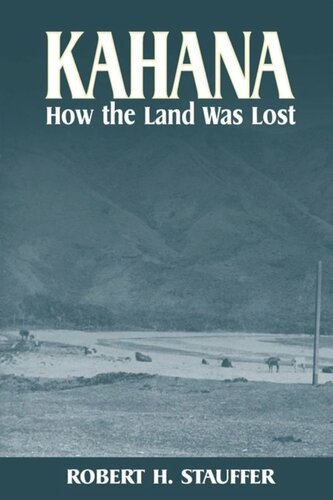

Most ebook files are in PDF format, so you can easily read them using various software such as Foxit Reader or directly on the Google Chrome browser.
Some ebook files are released by publishers in other formats such as .awz, .mobi, .epub, .fb2, etc. You may need to install specific software to read these formats on mobile/PC, such as Calibre.
Please read the tutorial at this link: https://ebookbell.com/faq
We offer FREE conversion to the popular formats you request; however, this may take some time. Therefore, right after payment, please email us, and we will try to provide the service as quickly as possible.
For some exceptional file formats or broken links (if any), please refrain from opening any disputes. Instead, email us first, and we will try to assist within a maximum of 6 hours.
EbookBell Team

4.7
86 reviewsThis volume is the most detailed case study of land tenure in Hawaii. Focusing on kuleana (homestead land) in Kahana, Oahu, from 1846 to 1920, the author challenges commonly held views concerning the Great Mähele (Division) of 1846-1855 and its aftermath. There can be no argument that in the fifty years prior to the 1893 overthrow of the Hawaiian monarchy, ninety percent of all land in the Islands passed into the control or ownership of non-Hawaiians. This land grab is often thought to have begun with the Great Mähele and to have been quickly accomplished because of Hawaiians' ignorance of Western law and the sharp practices of Haole (white) capitalists. What the Great Mähele did create were separate land titles for two types of land (kuleana and ahupuaa) that were traditionally thought of as indivisible and interconnected, thus undermining an entire social system. With the introduction of land titles and ownership, Hawaiian land could now be bought, sold, mortgaged, and foreclosed.
Using land-tenure documents recently made available in the Hawaii State Archives' Foster Collection, the author presents the most complete picture of land transfer to date. The Kahana database reveals that after the 1846 division, large-scale losses did not occur until a hitherto forgotten mortgage and foreclosure law was passed in 1874. Hawaiians fought to keep their land and livelihoods, using legal and other, more innovative, means, including the creation of hui shares. Contrary to popular belief, many of the investors and speculators who benefited from the sale of absentee-owned lands awarded to alii (rulers) were not Haole but Päkë (Chinese).
Kahana: How the Land Was Lost explains how Hawaiians of a century ago were divested of their land--and how the past continues to shape the Island's present as Hawaiians today debate the structure of land-claim settlements.